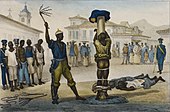
| Part of a series on |
| Corporal punishment |
|---|
 |
| By place |
| By implementation |
| By country |
| Court cases |
| Politics |
| Campaigns against corporal punishment |
Campaigns against corporal punishment aim to reduce or eliminate corporal punishment of minors by instigating legal and cultural changes in the areas where such punishments are practiced. Such campaigns date mostly from the late 20th century, although occasional voices in opposition to corporal punishment existed from ancient times through to the modern era.
The UN Committee on the Rights of the Child defines "corporal punishment" as:
any punishment in which physical force is used and intended to cause some degree of pain or discomfort, however light. Most involves hitting ("smacking", "slapping", "spanking") children, with the hand or with an implement – whip, stick, belt, shoe, wooden spoon, etc. But it can also involve, for example, kicking, shaking or throwing children, scratching, pinching, biting, pulling hair or boxing ears, forcing children to stay in uncomfortable positions, burning, scalding or forced ingestion.[2]
- ^ "States which have prohibited all corporal punishment". Global Initiative to End All Corporal Punishment of Children. Archived from the original on 19 December 2016. Retrieved 6 April 2017.
- ^ "General comment No. 8 (2006): The right of the child to protection from corporal punishment and or cruel or degrading forms of punishment (articles 1, 28(2), and 37, inter alia)". United Nations Committee on the Rights of the Child, 42nd Sess., U.N. Doc. CRC/C/GC/8. 2 March 2007. Retrieved 27 January 2015.
© MMXXIII Rich X Search. We shall prevail. All rights reserved. Rich X Search
